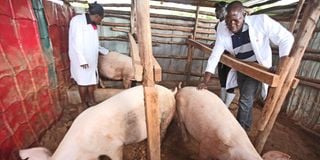Vet on call: Danger of central drainage system in the animal shed

Erick Okeyo, the owner of Pinnacle Farm in Kisumu County, checks on his pigs. With him are farm manager Violet Jahenda and a vet, Collince Oyuko. The pig disease called atrophic rhinitis is caused by two bacteria of the Bordetella and Pasteurella species and can be treated with antibiotics. It can also be controlled with vaccines but they are not available in the country.
What you need to know:
- The place was extremely cold, drizzling with visibility of about 100 metres due to dense fog. I hoped the piglets had good heating.
- Older pigs have no problem with such temperatures because they generate a lot of heat and have thick skin fat cover that protects them from body heat loss and the environmental cold assault.
- I advised the directors to provide handwashing soap since water alone is not a sufficient biosecurity.
- If the drainage trench traversed several pens, it should be deep and covered with pig-proof material.
The farm’s majestic gate reminded me of Nairobi, yet we were deep in the rural reaches of Kiambu County, very close to the Aberdare Ranges.
To get here, we had to negotiate sharp corners and climb steep inclines. I noted the farm was well-secured with barbed wire but not animal-proof.
I made a note there was no disinfectant water bath at the gate. I advised the owners to install one.
The place was extremely cold, drizzling with visibility of about 100 metres due to dense fog. I hoped the piglets had good heating.
Older pigs have no problem with such temperatures because they generate a lot of heat and have thick skin fat cover that protects them from body heat loss and the environmental cold assault.
Liz and the farm’s co-director, Mike, had picked me from my office early last week to help resolve a case of piglets that would start with sneezes and coughs, and then develop pus-filled pockets called abscesses on the snouts and jaws.
The disease would progress into distortion of the snouts. The farm directors were keeping pigs for the first time.
They wondered whether the piglets’ snouts would revert to the normal shape and structure after healing.
I proceeded to the piggery. It was fully secured with a stone wall and animal-proof gates. There was a washing station at the main entrance.
I advised the directors to provide handwashing soap since water alone is not a sufficient biosecurity.
Keep them warm.
The entrance had a water bath impregnated with magadi soda. I advised the use of a disinfectant such as quaternary ammonium compounds that kill all types of germs comprising bacteria, viruses, protozoa and fungi.
Magadi soda is good for foot and mouth disease but its activity on other micro-organisms is limited.
The piggery was very clean and well-maintained. The outer wall was made of stone and concrete.
It was well-raised to prevent draught but provide sufficient ventilation. The internal cubicle walls were also high to keep the animals warm.
The floors were well-slanted for good drainage. Piglets had infrared lamp heaters to keep them warm.
I noticed the foul water drainage trench traversed several pig pens before joining another to drain to the waste water pit.
Some pigs were busy scavenging in the waste water and even drinking some of it. That was very bad for hygiene in the piggery.
I explained to the two directors and their manager that foul water from each pen should not drain through the other pens.
If the drainage trench traversed several pens, it should be deep and covered with pig-proof material. The contents should not be available to the pigs to avoid disease transmission between the pens.
There were about 200 pigs on the farm. Some animals had skin parasites called mites. I advised weekly washing with a suitable synthetic pyrethrin compound known as pyrethroid. I confirmed the manager was using the same but noted the dose needed to be increased.
Improvement of hygiene and early treatment
Some piglets had diarrhoea that I was told kept recurring. I advised on antibiotic treatment in water but also explained the problem could be arising from the shared foul water drainage.
Some piglet groups had lots of sneezing and coughing. Some pigs had poor growth rate due to the persistent diarrhoea, sneezing and coughing.
Finally, we got to the piglets with deformed snouts. They were four in an isolation unit. Two of them looked like they were crosses of a donkey and a pig.
The snouts had swollen and were full of pus. They had grown long and curved at the front.
The other two piglets had open abscesses, which were healing after they were drained by the local animal health service provider.
The four piglets were too small for their age, were thin and the skin and hair were unhealthy. I diagnosed a disease called atrophic rhinitis caused by two bacteria of the Bordetella and Pasteurella species.
The piglets had been isolated from the groups that were coughing and sneezing to avoid contaminating the pens heavily.
I treated the piglets with antibiotics and gave a prescription of the drugs to be given to the sneezing and coughing piglets.
The disease can also be controlled with vaccines but they are not available in the country. I advised improvement of hygiene and early treatment of infected piglets at the stage of sneezing and coughing until the disease got properly controlled.
“Unfortunately, the deformed snouts are permanently damaged and will not revert to normal and the affected piglets will have a slower growth rate due to inefficient breathing,” I concluded to the directors.





